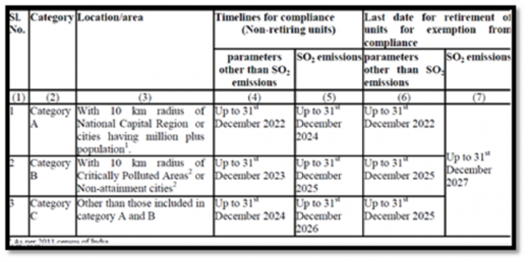Description

Copyright infringement not intended
Context: The Union Ministry of Environment, Forest and Climate Change (MoEf&CC) once again granted more time to the thermal power plants for meeting the sulphur dioxide (SOx) standards.
Details:
- Thermal power plants within 10 kilometres of the Delhi-National Capital Region or cities with million-plus populations were supposed to meet the SOx standards by the end of this year.
- The compliance deadline for this category of plants as well as the rest has now been pushed by two years.
- The March 31, 2021 notification divided the power plants into three categories A, B and C based on their location. A different compliance deadline was set for each category.
- Previous deadline for meeting emission norms (March 31, 2021 notification)

- The highlight of the March 31, 2021 notification was the inclusion of the penalty clause. The units which would fail to meet the standard within the deadline were to be fined based on rationale elaborated in this notification. An analysis by Delhi-based non-profit Centre for Science and Environment (CSE) showed that this penalty provision was ineffective and was just another hogwash.
- Despite the provision of the penalty clause in the March, 2021 notification, when MOEFCC felt that almost 50 per cent of the plants in category A will not meet standard in 2022, it once again extended the deadline by introducing the latest notification.
- The new notification has built in another criteria for distinction of compliance with the norms. Now, alongwith with location, compliance with different parameters will also have different deadlines.
- The old deadline, as defined in the March 2021 notification, remains the same for meeting particulate matter (PM) and nitrogen oxides (NOx) standards. The deadline for SOx implementation was extended by another two years for all the three categories.

Revised deadlines:

- In the case of retiring plants, the deadline for PM and NOX remains the same. The deadline for meeting the SOx norms for retiring plants was extended till 2027 by the latest notification.
- It is interesting to note that neither the Union Ministry of Power (MoP) nor the Central Electricity Authority (CEA) have provided a list of plants indicating their year of retirement.
- The new status report on SOx emission by CEA (May 2022) mentioned plants which will retire in the future. But the report does not talk about the year in which they will retire. This implies that these units will continue to pollute throughout the foreseeable future.
- More problematic is the fact that with each extension in deadline, the retiring units which are anyway more polluting owing to old technology and less efficiency, also get benefit of the extension.
- More than half the coal energy capacity (105 gigawatts) was already complying or was in the process to comply immediately with the PM norms, showed CSE report Coal-based power norms — where do we stand todaypublished in 2020.
- The remaining capacity (79 GW) was expected to comply with PM norms by 2019-2022, it added.
- Similarly, after dilution of the NOx standards for plants commissioned during 2004-2016, a large percentage of coal capacity was in a position to comply with NOx norms by 2021-22.
- Despite these facts, a large percentage has now been unnecessarily given a long deadline of 2024 for complying with PM and NOx norms.
- CEA, which is the regulator and monitoring agency for implementation of emission norms, only reports on SOx standards. No information is available in the public domain on compliance with PM and NOX norms. Then on what basis has MoEf&CCbeen extending the deadline for PM and NOx is a million-dollar question.
- The CSE report also highlighted that in 2020, a humongous 70 per cent units were not complying with SOx standards and had not even started the process for installation of SOx control equipment.
- Therefore, for long it is known to regulators that PM and NOx are not the challenge. Controlling SOx emissions is what they needed to work on.
- If MoEFCC was serious about implementation of standards, efforts could be made to advance the deadline for PM and NOx.
- MoEFCC issuing multiple notifications in concurrence with MoP and CEA to justify and legalise continuation of pollution by the power plants, only implies that health of the people and environment is the least of their concerns.
Timeline:
- 2015 In December, notification of stringent emissions limits issued for sulphur dioxide, nitrogen oxides, particulate matter, mercury and water usage of coal-based thermal power plants. Deadline end of 2017.
- 2017 Power plants granted five-year extension (till December 2022) to meet the deadlines in a phased manner. Eleven plants in Delhi-NCR were to comply with the norms by 2019.
- 2018 In June, water norms for units installed after January 2017 diluted from 2.5 m3/MWh to 3 m3/MWh.
- 2019 In May, NOx norms for units installed in 2004–16 diluted from 300 mg/Nm3 to 450 mg/ Nm3.
- 2021 MoEF&CC on March 31 issued notification specifying new deadlines for compliance, with the norms based on the location of the coal thermal power plants
- 2022 MoEFCC on September 5 issued a notification extending earlier deadlines
https://www.downtoearth.org.in/news/pollution/environment-takes-back-seat-moefcc-extends-sox-compliance-deadline-again-84754

















